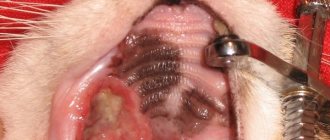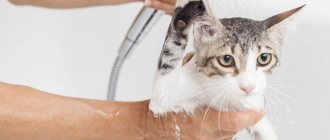Flea dermatitis in cats is one of the most common problems faced by lovers of these animals and from which not a single pet, even a carefully groomed pet, is immune. A similar reaction occurs as a result of an allergy to substances contained in the saliva of blood-sucking parasites. The initial manifestations of the disease can be noticed within ten to fifteen days after the flea bite, and the insects themselves may no longer be on the animal’s body by this time. It has been noticed that a cat with hypersensitive skin can react with a case of dermatitis after just two, or even one, flea bite. In this case, it is necessary to begin treatment immediately before the disease spreads to large areas of the body.
What is flea dermatitis?
Dermatitis is manifested by inflammation of the skin resulting from exposure to an irritant, that is, they are considered allergic diseases. For flea dermatitis to occur, it is not at all necessary that the pet be covered in fleas, since a couple of bites from random insects are often enough for its development. Young cats between nine months and three years of age, as well as those with short hair or hairless breeds, are considered to be most sensitive to such a reaction.
Up to two dozen different allergens can be simultaneously present in a flea's saliva, one of which is likely to lead to an allergic reaction.
The disease develops as follows:
- flea saliva containing the allergen after a bite gets on the skin or under the skin of the cat;
- the allergen penetrates the layers of the epidermis;
- subsequently it penetrates into the lymph;
- Together with the lymph, the allergen spreads throughout the animal’s body;
- in response, cells of the immune system initiate a protective reaction.
It has been noticed that manifestations of dermatitis occur not only at the internal level; quite quickly they also manifest themselves in the form of external rashes, which quickly progress and, if urgent measures are not taken, cause significant discomfort to the cat and even change its behavior.
Symptoms of flea dermatitis in cats
An allergic reaction caused by flea dermatitis cannot have a long latent period; diseases of this kind appear quickly and are quite pronounced.
The cat's behavior will begin to change, it will become restless, and upon careful examination of your pet, you can find the following:
- severe itching in a cat causes the animal to constantly itch; scratching in certain places with rashes can merge into limited weeping areas;
- changes in character are noticeable, the cat becomes restless, nervous, and may lose interest in food;
- in areas with rashes, hair loss, deep scratches and redness are observed;
- fleas and traces of their vital activity in the form of dark feces can be found on the skin;
- the rapid development of the disease leads to the formation of scabs in areas of scratching;
- the addition of a secondary infection threatens inflammation with purulent discharge.
A disease such as flea dermatitis can have an acute form, which can become chronic. The most affected areas of the skin are those located on the abdomen, around the ears, and on the back, and they tend to increase and gradually cover more and more new areas. If dermatitis occurs in a chronic form, then exacerbations of the disease are most often observed in the summer.
Symptoms
The disease occurs in acute and permanent forms. The intensity of pathological changes depends on the degree of personal intolerance to the stimulus. Visible changes are observed on the trunk and thighs; the muzzle and limbs are not affected. The acute form of dermatitis is characterized by the following symptoms:
- Itching.
- Formation of papules with a red border.
- Formation of areas of weeping eczema.
The chronic course of skin pathology has the following manifestations:
- Foci of baldness form.
- Fibrous nodules develop and are constantly itchy.
- The affected area is stained with flea waste products.
With both types of dermatitis, the cat's behavior changes. The cat itches intensely, meows, and may bite. Abscesses, ulcers or nodules, and brownish feces of parasites are found on the skin. The disease is complicated by the addition of opportunistic microflora. The affected surface of the skin is dry, overgrown with crusts, covered with scales and papules.
Baldness of the abdomen
Kinds
Allergic flea dermatitis in cats can occur with varying intensity and some differences in the symptoms shown. Based on these features, the disease is classified into three types:
- Sharp look . Characterized by severe skin itching.
- Subacute appearance . It is an intermediate stage between the acute nature and the transition of the disease to a chronic form.
- Chronic appearance . It is characterized by the formation of nodules on the skin, also accompanied by itching. On damaged skin, hair loss occurs with the appearance of bald areas.
The acute form of flea dermatitis in cats can quickly become chronic, which occurs in the absence of timely treatment or if it is carried out incorrectly. The disease will return until the correct way to eliminate it is found.
Who is most susceptible?
Despite the fact that flea dermatitis is considered a fairly common form of allergy and is seasonal, not all animals suffer from this disease. For many of them, flea bites pass without a trace, causing only anxiety from the direct bite and not causing flea dermatitis in the cat. Cat breeds with short hair or completely hairless are more predisposed to such a reaction to substances contained in the saliva of parasites.
Particular attention should be paid to your pets during the warm season; it is during this period that the possibility of flea bites increases. Moreover, for this it is not at all necessary to be on the street; the owners themselves can bring them home on street shoes and infect the pet.
Treating flea dermatitis at home
Fleas on a kitten.
It should be immediately clarified that this cannot be done purely at home.
First of all, if there are no obvious signs of a flea infestation (that is, it is not clear whether fleas are actually the cause of the allergy), and the results of the wet paper “test” are questionable, you need to contact the clinic.
There, doctors will determine whether there is a problem with fleas, whether scratching is really the result of an allergy, and will rule out other possible dermatological problems, because scratching and shedding of fur can be not only due to flea dermatitis, but also for many other reasons.
These include, for example, lichen , and a variety of microscopic mites that live on or in the skin of an animal.
A cat may scratch itself not only because of flea dermatitis, but also for other reasons, such as microscopic mites.
And also, if the animal has severe itching, it must be “stopped” - that is, stopped for a while. This is done with an injection of a drug specifically designed to stop allergic reactions. This drug contains a glucocorticosteroid. Perhaps after this injection the itching will not recur.
Fighting allergies
Regardless of whether the cat was given an injection or not, you need to fight the very cause of the allergy. The mechanism of this fight is simple. It consists of two points.
- Consistently strictly treat the cat with insecticidal drops three times at an interval of three weeks.
- Giving anthelmintic drugs.
- General cleaning and treatment of the premises with insecticidal agents intended for this purpose.
To prevent your cat from developing allergies, you need to clean the apartment more often.
You can choose any insecticidal drops from the range of a pet store or veterinary pharmacy, guided only by the financial aspect.
Intensive therapy for flea dermatitis
Despite the fact that the instructions indicate an interval of 4 weeks, in the case of flea dermatitis, “intensive therapy” is needed. This will not harm the cat's health. But in no case should you drip it more often, or especially every day - this can cause intoxication.
The best option is drops that act on both exo and ectoparasites. That is, with this drug you can immediately get rid of two problems - fleas and helminths. As mentioned above, fleas very often carry worms, so such treatment is necessary.
If there is no opportunity or desire to purchase such drops, you can separately buy flea drops and tablets or suspension for worms. Drops and tablets/suspension can be used at intervals of one day.
Flea treatment is necessary!
Drops from fleas (or fleas and worms) drip in the area of the withers (where the cat's shoulder blades are), and not on the fur, but specifically on the skin.
To do this, the cat's fur is parted and a drop of the drug is applied at several points. But you need to carefully ensure that none of these points are within the reach of the cat’s tongue.
Deworming tablets
Anti-worming tablets can be crushed into food, but it is not a fact that the cat will want to eat it. You can forcefully give it to the root of the tongue, but many cats manage to spit it out anyway. The suspension is put into the animal’s mouth from a syringe, but you need to squirt it out as far as possible so that everything doesn’t spill out of the mouth. The cat may begin to salivate (they are very sensitive to bitter tastes), and because of this, the medicine may also spill out.
When treating a cat, do not forget that worms can be transmitted to humans.
Perhaps these difficulties with administering an anthelmintic drug are another plus in favor of complex drops.
How to diagnose fleas?
Flea dermatitis can be suspected in a cat based on some specific signs that are easy to detect if you pay close attention to it. You just need to take a closer look at the animal and pay attention to changes in its behavior.
If the flea infestation has not yet reached scale and is at the initial stage, then you can check your cat for their presence as follows:
- Place the cat on a clean sheet of white paper.
- Using a comb or brush, comb the animal's fur in different directions.
- Particles of skin, fur, or small black grains resembling dirt may appear on white paper.
- If these particles are crushed, brown or brown marks remain on the paper.
- These particles are flea feces, and the color confirms that the fleas are feeding on the animal's blood.
Such confirmation serves as direct evidence that the cat has fleas, even if there are no other symptoms of infestation. Only a veterinarian can confirm whether their presence is a cause for dermatitis. It is impossible to independently diagnose the flea form of dermatitis, since completely different diseases that do not depend on the presence of skin parasites often exhibit similar symptoms. If, during examination by a specialist, the diagnosis of flea dermatitis is confirmed, then the animal will be prescribed treatment in accordance with the breed and age of the pet, as well as taking into account the form of development of the disease and the degree of damage. Correct prescriptions will not only stop the external manifestation of the disease, but will also prevent its relapses.
Photo
As a rule, most cases of flea dermatitis can be easily diagnosed by external signs. If you carefully examine the skin of an animal, it reveals the characteristic manifestations of this skin disease.
So, in a photo taken from the affected area of skin you can see:
- characteristic scratches in the form of bloody deep scratches;
- swelling of the skin with the presence of nodes, blisters, and ulcers;
- areas of skin with excessive dryness;
- redness of the skin with pronounced inflammation;
- purulent discharge may be noticed, which is characteristic of an infection.
Despite the obvious severity of symptoms consistent with the development of flea dermatitis, the final conclusion about the type of disease must be made by a veterinarian. Therefore, treatment of the disease should be carried out under his control and with the help of medications prescribed by him.
Treatment of dermatitis
Drug treatment of flea dermatitis in domestic cats is carried out according to a standard regimen, which involves the use of the following medications:
- drugs with anti-inflammatory effects;
- medicines with antibiotic properties;
- antiphlogistic nonsteroidal drugs.
When treating, you need to focus not only on the choice of medications that can cope with the flea form of dermatitis. It is equally important to create the necessary living conditions for the animal.
Antihistamines
To treat cats with symptoms of flea dermatitis, medications containing calcium sodium thiosulfate and hormones are used. With the help of calcium in the drug, it is possible to reduce vascular permeability, eliminate swelling and reduce itching. However, their disadvantage can be considered some features of application, when their administration involves only intravenous injections, which can only be done by a specialist.
The use of sodium thiosulfate is also carried out only intravenously and strictly in accordance with the prescribed course. Thanks to it, the allergic reaction is stopped, which relieves the cat of disturbing symptoms. Moreover, if you seek help early and start treatment in a timely manner with such a drug, you can completely get rid of allergies.
However, antihistamines occupy a special place in methods of therapy aimed against flea dermatitis. With their help, you can quickly cope with itching, and intended for animals, they do not have a harmful effect on their body. These medications are usually given to your cat for three to five days, after which only your veterinarian can decide whether to continue treatment or stop it. The most effective antihistamine medications for cats are prescribed Suprastin, Tavegil, Diphenhydramine or Zyrtec. Chlorpheniramine, which is taken orally twice a day, 2 ml, copes well with this task.
In some cases, antihistamines are not effective enough against allergies, then it is recommended to treat flea dermatitis using glucocorticosteroids.
Hormonal
Hormonal medications are very often prescribed for severe forms of allergies in animals. Typically, Prednisolone is used for these purposes, starting the course of treatment with a high dose and gradually reducing it. The dosage depends on the weight of the cat and its age, due to which the expected result with the elimination of the symptoms of an allergic reaction occurs in a short time. When carrying out treatment with hormonal drugs, it is necessary to take into account their downside, that is, their adverse effect on the vital processes of the animal’s body. Thus, their use may reduce immunity, disrupt metabolic processes, and complicate the processes of digestion and assimilation of food. It is for this reason that hormonal drugs should be used only if indicated for this type of treatment and not used for a long time.
Often a sick animal is offered local hormonal agents as a cream or ointment. Such a prescription is justified in case of contraindications to the use of systemic drugs.
How to treat a cat for flea dermatitis?
There is an opinion among cat owners that if you remove fleas, the dermatitis will disappear on its own. This is fundamentally incorrect, since allergies in dermatitis are systemic in nature and the changes caused by them require complex treatment. In some cases, spontaneous disappearance of symptoms is observed. This usually happens when fleas are noticed and removed quickly, and the affected animal is in good health.
Preparations for killing fleas on animals and household items
Complete destruction of fleas is a prerequisite for recovery. Unlike ordinary animals, an allergic cat reacts with dermatitis even to single bites.
Preparations for removing fleas:
- Drops on the withers "Advantage" for monthly treatment (safe for kittens);
- Stronghold drops are effective for a month (approved for use from 6 weeks of age);
- Frontline drops are used at intervals of 2 months (for kittens from 8 weeks and older);
- Anti-flea collars “Hartz”, “Clandestine” (validity period – from 4 to 7 months);
- Zoo shampoos “Fitoelita”, “Mr. Kiss”, “Biovax” (require careful rinsing, as they can get into the cat’s stomach when licking the fur).
Isolated treatment of the animal is not enough, since insects freely jump onto surrounding objects. The cat's toys, his rug and other places where pests may be located, their larvae or eggs should be treated with a product such as "Delcid", rinsed well and dried. If you have a steam cleaner in your home, it is recommended to regularly treat carpets, upholstered furniture and cat beds with hot steam. Animal rugs can also be ironed through cotton fabric with a hot iron in the steam mode.
Symptomatic treatment: antipruritics and sedatives
Applying a protective bandage does not have any effect, since a dexterous animal can easily pull it off from any part of its body. A special insulating collar helps solve this problem, preventing the cat from reaching its back or paws.
Types of topical antipruritic drugs:
- hydrocortisone ointment (0.5%);
- wound-healing powder Tsamaks (contains a natural sorbent zeolite, dries and soothes irritated skin);
- "Stop Itching" spray with triamcinolone, chloramphenicol, metronidazole and calendula extract (irrigate the affected areas 2-3 times a day, course of treatment - from 5 to 7 days).
Antihistamines
Histamine is released into the blood by mast cells and is one of the main components of the allergic reaction. Special antihistamines, by binding to histamine-sensitive receptors, help quickly relieve many allergy symptoms.
Types of antihistamines:
- First generation drugs (Suprastin, Tavegil, Fenkarol). They bring quick but short-term relief, so for a lasting effect they need to be taken several times a day, which is not very convenient. The optimal dose of Suprastin is about 7 mg (a quarter of a tablet) for an animal weighing 5 kg. During treatment with them, the animal may become inhibited. With long-term therapy they become addictive.
- The second generation of drugs (Cetirizine, Loratadine) have a prolonged effect, so they are taken 5 mg once a day. They cannot quickly relieve symptoms, but act gradually. There is no side effect such as drowsiness.
- The third generation of antihistamines (Xyzal, Erius) are designed for single daily use. They do not cause addiction or drowsiness. Drugs in this group are the most expensive of those listed; their dosage must be determined by a veterinarian.
Video - How to give a cat a pill
Often there is a need to treat a pet with tablets and then the question arises: what is the best way to do this?
To do this, you can use the recommendations of specialists or watch the video:
- Carefully study the instructions for the drug and determine the prescribed dosage.
- Decide on the permissibility of giving the medicine with food or dissolved in water.
- Limit the animal's mobility by wrapping it tightly in a thick blanket or towel.
- Raise the cat's head and open its mouth.
- It should be taken into account that the animal will struggle, so it is necessary to hold it still with your free hand.
- By pressing on the lower jaw, it is necessary to open the mouth. Moreover, if you are supposed to give a pill, the mouth must be opened as wide as possible.
- The tablet is inserted with two fingers, trying to get as far as possible to the root of the tongue.
- You must make sure that the tablet is swallowed. To help with this, you can blow lightly into your cat's nostrils, which will trigger the swallowing reflex.
- Release the cat from the blanket and offer it water.
If the animal is strong enough and actively resists, and the fear of inserting fingers into its mouth turns out to be stronger than the desire to help it, then you can insert the tablet using special plastic tweezers, which can be bought at a veterinary pharmacy.
How to treat allergies in cats
Before proceeding with further treatment after prescribing therapy, it will be necessary to carry out preliminary prevention and do the following:
- Treat the cat's fur with a special spray or drops for such purposes, or wash it with anti-parasite shampoo.
- Replace the bedding where the pet slept with a new one, and be sure to throw away the old one.
- Subject the animal's toys to thorough treatment with special means.
- Disinfect the home using disinfectants.
- Other pets living in the house with an infected cat must also be treated with flea control.
You might be interested in: Why does a cat have dirty ears?
Veterinarians recommend isolating an infected pet, preferably in a separate room, and limiting its movement around the house if possible. Be sure to treat carpets and interior items with antiparasitic drugs, since a large number of fleas usually accumulate on these things.
When choosing a shampoo, drops, or anti-parasite spray, you should pay special attention to the anti-flea substance they are made from. One of the common insecticides included in the product is permethrin. Anti-parasite collars are more suitable for preventing parasite infestation.
To quickly eliminate the characteristic symptoms of flea dermatitis, comprehensive treatment of the animal is used. Glucocorticosteroid drugs that have the greatest effect have proven themselves to be effective, such as:
- “Stop-Itching” - a suspension or spray containing polcortolone and methionine;
- "Dectaford" - based on dexamethasone;
- “Septo-spray” - with the active ingredient iodopovidone;
- "Atop-7" - made on the basis of plant antimicrobial extracts;
- "Allerderm Spot-on" - drops containing useful components that promote the rapid restoration of the protective layer of the skin;
- “Aluminium” is a spray with a strong antiseptic and wound-healing effect;
- "Alamicin" is an aerosol based on oxytetracycline hydrochloride, suitable for the treatment of many skin infections.
If a domestic cat has had an allergic reaction to saliva at least once after being bitten by parasites, it means that relapses are possible in the future, so it is necessary to keep anti-flea medications in the house.
Flea dermatitis significantly reduces the immune system, so you should properly balance your cat's diet so that the food contains enough nutrients to maintain immunity. It is important to carefully monitor your pet's reaction to medications.
If signs of acute intolerance or other side effects occur, you should consult a veterinarian to decide whether to replace the drug used with a similar drug.
Diet
When relieving a pet of the symptoms of an allergic reaction to flea bites, it is necessary to help the body cope with this change in its condition with the help of special nutrition. Thanks to this, the skin healing process will happen faster, and inflammation and itching will disappear. If the cat eats natural food, then it is necessary to add Omega-3 acid, for example, Nordic naturals Omega.
If you prefer dry ready-made food, it is better to use Royal Canin Skin or Econuba Dermatosis. For a while, it is necessary to give up chicken-based food and not give chicken as food, since it is this type of food that most often contributes to allergies.
Treatment regimens for cat allergies
Ridding an animal of parasites is not a sufficient measure to treat allergies. Depending on the symptomatic picture and the presence or absence of complications, appropriate drug therapy is selected.
Symptomatic therapy
For symptomatic treatment, drugs mainly from the hormonal pharmacological group are used:
- Prednisolone. The dosage ranges from 0.5 to 1 mg for every 1 kg of animal body weight. Prednisolone is used in tablet form.
- Dexaforte. The amount of the drug is 0.05 ml per 1 kg of weight. Dexaforte is used to treat animals that have excessive aggression due to allergies, and pets that spend a lot of time outdoors, where the risk of re-infection is high.
In addition, it is recommended to give antihistamines such as Tavegil, Zyrtec and Suprastin.
Prednisolone is a white or white with a slight yellowish tint crystalline powder in odorless tablets.
If a cat has constant access to the street, despite the treatment, she has a risk of re-infection with fleas and developing allergies. To avoid this, veterinarians recommend immunotherapy – introducing a small amount of an allergen into the animal’s body.
When a small amount of an irritating substance is constantly introduced into the body, the cat’s immune system begins to actively produce antibodies. Over time, their concentration increases, and the body ceases to be sensitive to the allergen.
Immune therapy in cats in 85% of cases gives a positive result, which consists in the complete elimination of allergies, even in the presence of fleas in the fur.
Antibiotics for severe cases
Antibacterial drugs are prescribed if the cat, due to an allergic reaction and severe scratching, has inflammatory processes (purulent) on the skin, and an infection has entered the wounds.
Antibiotics are substances that inhibit the growth of living cells, most often prokaryotic or protozoan.
Antibiotics for cats can only be prescribed by a veterinarian. Drugs with a wide spectrum of effects are used. The duration of the course is 14 days.
Skin restoration products
Allergies primarily negatively affect the condition of the coat: it loses its shine and strength, and actively falls out. Bald spots appear on it. Treatment of the pathological condition includes careful and proper care of the coat. To quickly return it to its normal state, special vitamin and mineral supplements are used.
They should contain fatty acids:
- Nordic Omega-3 Naturals;
- Medizinal Dorschlebertranl.
Additionally, special drops for wool are prescribed: Essential-6 or Allerderm.
If the owner feeds the cat with finished industrial products, it should be replaced with dry food, which contains all the elements necessary for hair restoration. Recommended foods with medicinal effects: Derma ProPlan Plus, Hill's z/d, Coat Formula and Royal Canin Skin.
Drops
To eliminate the discomfort caused by flea dermatitis in cats, you can use special drops designed for this purpose and approved for the treatment of allergies in animals. In this capacity, veterinarians advise using the following types of liquid preparation:
- Essential 6 - with the help of this product, the animal quickly gets rid of itching, and they also serve as a guarantee to prevent repeated cases of infection. An additional advantage is the packaging with a small dosage;
- Stronghold are drops that can be used for adult cats and kittens from three months of age.
Using these remedies, you can get rid of parasites on the animal’s body within 24 hours, thereby it will stop suffering from itching and anxiety.
Powder
You can alleviate the condition of an animal when it develops allergic dermatitis as a result of a reaction to flea bites using powder. Most often, powders such as:
- Tsamaks - has wound-healing properties;
- Synthesis - when applied to damaged skin, accelerates its healing, and also effectively relieves inflammation and swelling.
The combination of components in these powders allows you to quickly cope with a problematic situation.
Collar
Using a collar will not get rid of parasites, but it will protect a clean and healthy animal from their penetration. Most often, the following types can be purchased in veterinary pharmacies:
- Leopard - capable of reliably protecting a cat from fleas for seven months, since its characteristic smell repels parasites;
- Baffo - the impregnation of this collar is distinguished by a large number of anti-parasitic components, but they can only be used on animals older than three months.
You should not assume that using a flea collar does not pose any danger to the animal itself. There are cases, however, so far isolated, that the composition used for impregnation can also cause allergies.
Shampoo
As an effective remedy against fleas, special shampoos can be used, which are presented in a large assortment, namely:
- Kiss shampoo - produced in Sweden, it simultaneously kills insects and moisturizes the skin;
- Rolf Club shampoo is a product considered the most effective against fleas, but its more aggressive composition does not allow its use on animals under three months of age.
Many types of shampoos intended for animals, in addition to getting rid of parasites, gently care for the skin, prevent dryness and flaking, and the coat becomes silky and thicker.
Do all cats with fleas get this disease?
The presence of fleas on an animal's skin does not always lead to allergies. Several factors influence the occurrence and development of the disease:
- the amount of allergen that has entered the body (depends on the number of insects on the body of a particular animal);
- duration of exposure (the longer a cat is infected with fleas, the higher the likelihood of dermatitis);
- reactivity of the immune system (pets prone to allergies suffer more often);
- age (mainly adult animals are affected; kittens under 6 months of age rarely develop the disease due to their immature immune system);
- recent acute illnesses, the presence of common chronic diseases, poor nutrition, poor care (these factors weaken the body as a whole and reduce the reparative potential of the skin in particular).
Spray
Topical sprays are most suitable for contact allergies and flea dermatitis caused by a reaction to fleas.
- Nartz spray has the advantages of a large volume and the presence of several types of the drug, allowing it to be used in accordance with the age and weight of the animal. It has hypoallergenic properties and can be used from one month of age.
- Front-line spray - due to its sufficient volume, it allows you to extend use up to one and a half years, and one application protects the cat from fleas for up to 40 days.
The use of a spray allows you to relieve the animal from itching and obtain an antibacterial and anti-inflammatory effect.
Folk remedies
To effectively treat flea dermatitis, traditional medicine is often used, which is not inferior to medication at the initial stage of development of the infectious disease. These methods are good because they have virtually no side effects and are absolutely safe for the animal itself. For more advanced forms of dermatitis, folk remedies are used as an auxiliary addition to the main therapy.
To relieve unbearable itching and disinfect wounds from scratching, you can use decoctions of the following herbs:
- chamomile;
- celandine;
- calendula;
- sage;
- series.
Brew two tablespoons of dry and crushed herbs with a glass of boiling water. This decoction should be left to steep for an hour, then filtered. Using a cotton swab soaked in herbal infusion, treat the affected areas on the pet’s skin.
You cannot treat your cat with gasoline or kerosene - these products will certainly destroy fleas, but can cause great harm to the pet's health.
Small bite wounds can be moistened with a water-alcohol solution or peroxide. But if you do not rid the animal of parasites, traditional methods in the fight against dermatitis will be powerless. To kill the fleas themselves, you can resort to a vigorous solution of wormwood. You can also treat cat litter with this infusion to eliminate eggs and hatched flea larvae.
You may be interested in: The cat began to sneeze frequently: causes and dangerous symptoms
Traditional methods of treating fleas in cats
You can try to alleviate the animal’s condition and treat flea dermatitis in cats at home using traditional methods that will complement the main treatment with medications. To do this, they often use a composition of equal parts of olive and lavender oils and soapy water. Soak a cotton pad in the solution and apply it to the surface of the skin before and immediately after bathing the cat.
The same effect, eliminating irritation and swelling, as well as relieving itching, can be obtained by rubbing with chamomile decoction.
However, if your veterinarian does not recommend using such methods on your animal, then it is better not to use them.
Prevention of flea infestation
Prevention of flea infestation is quite simple - you need to be attentive to your pet and follow simple rules:
- Examine your cat daily. This will allow timely detection of infection. In such cases, a single treatment is sufficient for complete recovery.
- Periodically wash the bedding in water with added flea treatment for cats. Owner reviews indicate that this significantly reduces the risk of infection.
- Do not let your animal go outside without a prophylactic collar. After a walk, it is advisable to carry out antiparasitic treatment.
- Periodically, in consultation with your veterinarian, oral medications may be taken. Prevention is carried out once every 3 months.
Accompanying illnesses
Flea dermatitis is dangerous due to its complications, the most common of which are:
- development of atopic dermatitis, ending in the formation of lesions;
- the addition of bacterial infections, accompanied by vomiting, diarrhea and symptoms of fever.
If this happens and the cat’s condition does not improve within a few days, then you should immediately consult a veterinarian. To prevent the development of concomitant diseases and complications, it may be necessary to review and change the prescribed treatment regimen.
Prevention
Today there are no effective remedies that could completely protect against allergies to flea bites. To prevent their pet from suffering from flea dermatitis and its complications, owners must protect it from the possibility of infection.
To do this you should:
- do not allow street walks;
- when traveling to the country, pre-treatment against fleas is necessary;
- in case of high humidity, it is better to reduce walks in the air to a minimum;
- Carry out a thorough monthly inspection of the animal for the presence of fleas, and repeat treatment with drugs that have not expired;
- carry out wet cleaning more often in the room where the cat is;
- treat upholstered furniture and carpets with antiseptic agents;
- When you come home, do not leave dirty shoes in the hallway, but after washing them, put them in the closet.
If your pet has undergone treatment for dermatitis and it was successful, it is recommended that its condition be monitored by a veterinarian for several months. This is necessary for timely action in case of relapse.
How to protect your cat from re-infection?
There are cases when, after treatment, fleas appear again, literally within a few days. And the reason for this is improper treatment of the house. Owners are very interested in how to remove fleas from cats and few people care about such details as a comb, a bed, etc. And all this also needs careful processing. It is important to do a thorough cleaning of the house. Thoroughly wash all your cat's favorite places in the house. Pay special attention to the scratching post. The bedding should be washed at high temperature, after which everything should be thoroughly treated with flea and tick repellent for cats. It is recommended to treat even walls in the house at a height of up to 1 m from the floor with anti-flea agents.











